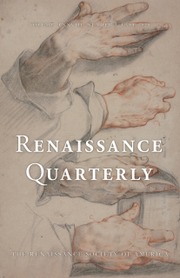Article contents
Marking Time: Astrology, Almanacs, and English Protestantism*
Published online by Cambridge University Press: 20 November 2018
Abstract
This essay correlates changes in early modern astrological almanacs with broad changes in early modern English Protestant culture over the sixteenth and seventeenth century. These almanacs show an increasing tendency to be highly specific as to place and time and to suggest that precise times and precise places are given a larger meaning by their relationship to the stars and planets wheeling overhead. By lending a vertical significance to place and time, almanacs run counter to early modern Protestantism, which suggested that place and time have no inherent sacred significance. Thus the rise of the early modern astrological almanac may have been impelled by a desire on the part of early modern men and women to have time and place mean something.
- Type
- Research Article
- Information
- Copyright
- Copyright © 2007 Renaissance Society of America
Footnotes
I am grateful to Anne Lake Prescott for her helpful commentary on an earlier version of this article.
References
- 11
- Cited by




